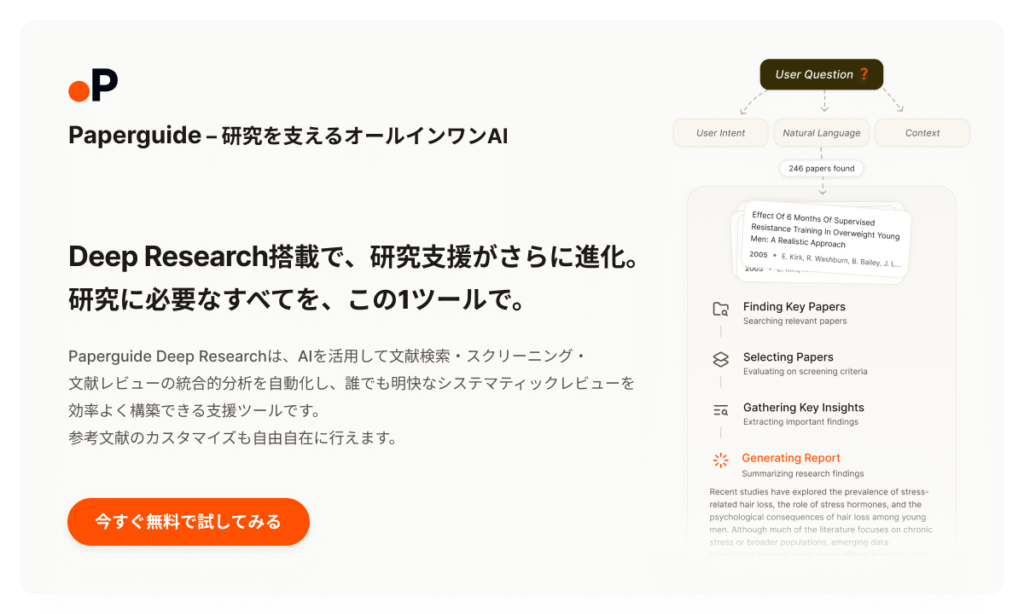
why?The number of post-doctoral fellows has increased so much.?
If you are aware of the difficult situation of young researchers, you must have at one time or another asked yourself the following questions.
I would like to review the history of how the number of post-doctoral fellows has increased in this way.
 Akanon
AkanonKeywords.
What was overdoctoring half a century ago?
In those early days, there were very few and precious few people who were considered to be PhDs.
However,D.'s began to increase after the 1950's, and researchers who could not find employment after earning their Ph.has emerged.
These researchers often remain in the lab without pay until they find employment,unemployed person with a PhDIt was called.
Especially prevalent in the 1970s, when they were unable to find employment.without payD., who remained in the lab.
As of 1970, about 2,600 people, or about one-fourth of all doctoral graduates, had completed their Ph.Unpaid researcherIt is said that he remained at the university as a
 Akanon
AkanonUnpaid?
How the number of overdoctors increased
Policies to increase the number of Ph.
The number of PhDs has increased over time, but this reflects the will of the national government.
After the 1950s, when postwar reconstruction was well underway and the shortage of human resources in the science and engineering fields was becoming more serious.
In particular, the industry was reportedly strongly concerned about the shortage of engineers in the heavy industry and chemical industry sectors, such as electricity, chemicals, and machinery.
To solve the shortage of scientific and technical personnel, the Japanese governmentTrain a lot of scientists!"and waved a flag.
Policy focusing on the training of scientific and technical personnel: "Expansion Plan for the Training of Scientific and Technical Personnel" (1957)
Furthermore, the National Income Doubling Plan of 1960 expanded this plan, increasing the number of science and engineering students by 20,000 over a two-year period beginning in 1961.
and, at the same time, to increase the quality and quantity of faculty to educate the workforce, there was a need to increase graduate school capacity.
Excess doctor goes to overdoctor.
In the 1960s, an increasing number of PhDs joined the faculty of universities that were expanded or newly established.
However, in the 1970s, there were not enough receptacles in academia and business to absorb the growing number of graduate students, and many of them could not find employment.
Those doctors were to remain in the laboratory without pay.
These doctors were called.unemployed person with a PhDIt was called "the most important thing in the world," and it was a social problem at the time.
As of 1970, the number of Ph.D. graduatesone out of fourare reported to have been overdoctored. (about 2,600 people)
 Akanon
AkanonI didn't realize that the problem of finding a doctoral degree has been going on for 50 years now?
Serious overdoctoring
The overdoctoring problem became even more serious following the first oil shocks in 1974 and 1979.
In the early 1980s.Over 3,500 overdoctorsThe company's efforts to promote the project have been covered by newspapers and magazines.
In addition to this, various social movements are taking place.
- The "Association of Young Researchers' Organizations Aiming to Solve the Overdoctoring Problem" is established, and a wide range of activities including surveys, research, meetings, and proposals are carried out.
- In 1983, "White Paper on Overdoctors: A Warning to the Academic System (Aoki Shoten)" was published.
Gradually, this issue began to be discussed in the Diet.
The Birth of Postdoctoral Fellowship and Gakusho
And as a response to the overdoctoring problem, the drop-off point was the currentpostdoctoral researcherIt is!
postdoctoral researcherImproved treatment by paying salaries as
 Akanon
AkanonSo at least give us a salary!
One way to deal with this,
The JSPS Fellowship Program, also known as theJSPSBirth (1985)
 Akanon
AkanonThe familiar academic swing!
From Overdoctoring to Postdoctoral Issues
Overdoctoring problem temporarily eases
The overdoctoring problem, which was feared to be serious, was actually alleviated in the 1990s.
 Akanon
AkanonWhat! I can't believe that the uproar was eased before I knew it?
It is said that there are two reasons for this.
- The entrance of the second baby boom generation to college increased the capacity of universities and the demand for university faculty.
- The bubble economy led to a shortage of human resources.
This means that it is easier to find employment in both academia and the private sector.
To a policy of increasing the number of Ph.
- Shortage of human resources due to the bubble economy
- Foreign governments point out that Japan lags behind in basic research from a global perspective
This is the social background of the company,
- The Graduate School Emphasis Policy.
- The 10,000 Postdoctoral Fellows Support Plan (Postdoctoral Fellows 10,000 Plan)
The policies were simultaneously implemented to further expand Japan's basic research capabilities.
Graduate School Emphasis Policy
The "Graduate School Emphasis Policy," which began in the 1990s, is designed to
- Expansion of Graduate School
- Increase in graduate students
In particular, the plan to increase Drs,
Plan to double the number of graduate students in 10 years (1991)
As expected, the number of Ph.D.s increased steadily until its peak in 2006.
Click on the image to enlarge/.
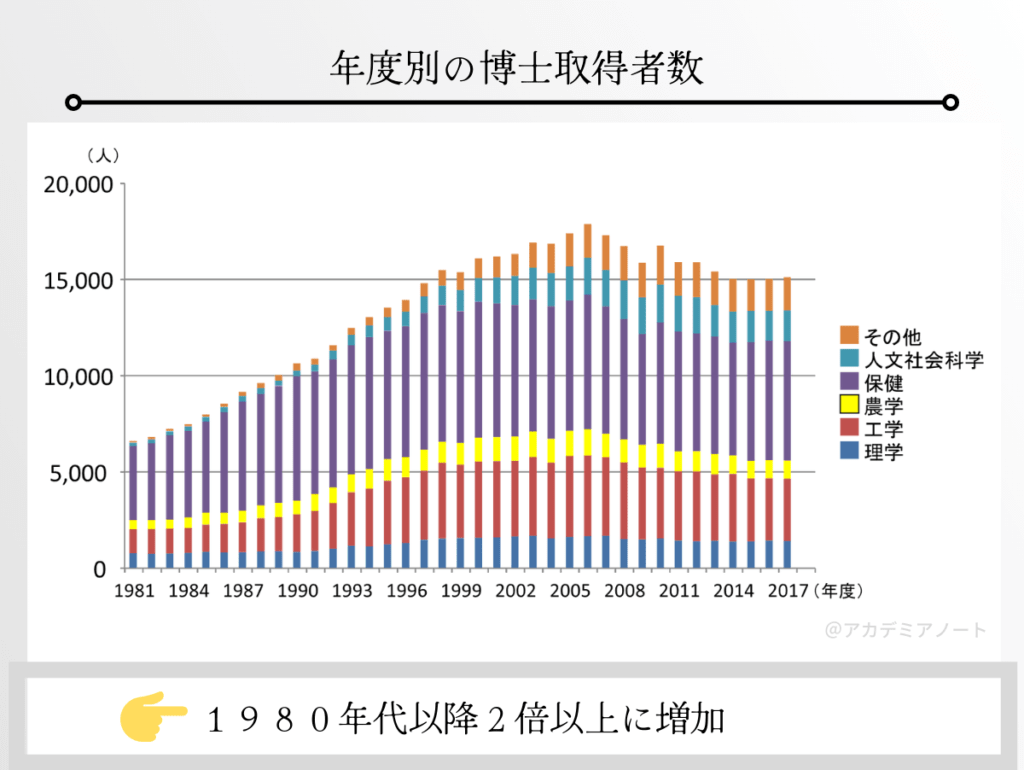
Postdoctoral fellowship plan for 10,000 people
The Postdoctoral Fellowship Program for 10,000 Postdoctoral Fellows (commonly known as the Postdoctoral Fellowship Program for 10,000 Postdoctoral Fellows) is a five-year plan established by the Ministry of Education, Culture, Sports, Science and Technology (MEXT) for the period from 1996 to 2000.
 Akanon
AkanonAs the name suggests, the policy sought to increase the number of post-doctoral fellows to 10,000.
How did this policy come about?
By establishing the post-doctoral period as a career path before taking up an academic post,Increase the number of researchers employedAiming at the development of science and technology in Japan
This is called.
For that reason,Distribution of time-limited employment funds to universities and other research institutionsI did.
It was thought that post-doctoral fellows would be a temporary replacement for the increased number of doctoral degree holders due to the policy of emphasizing graduate school, and that they would eventually be assigned to university faculty positions.
However, compared to the rapid increase in the number of Ph.The number of university faculty hired did not increase.(Figure below)
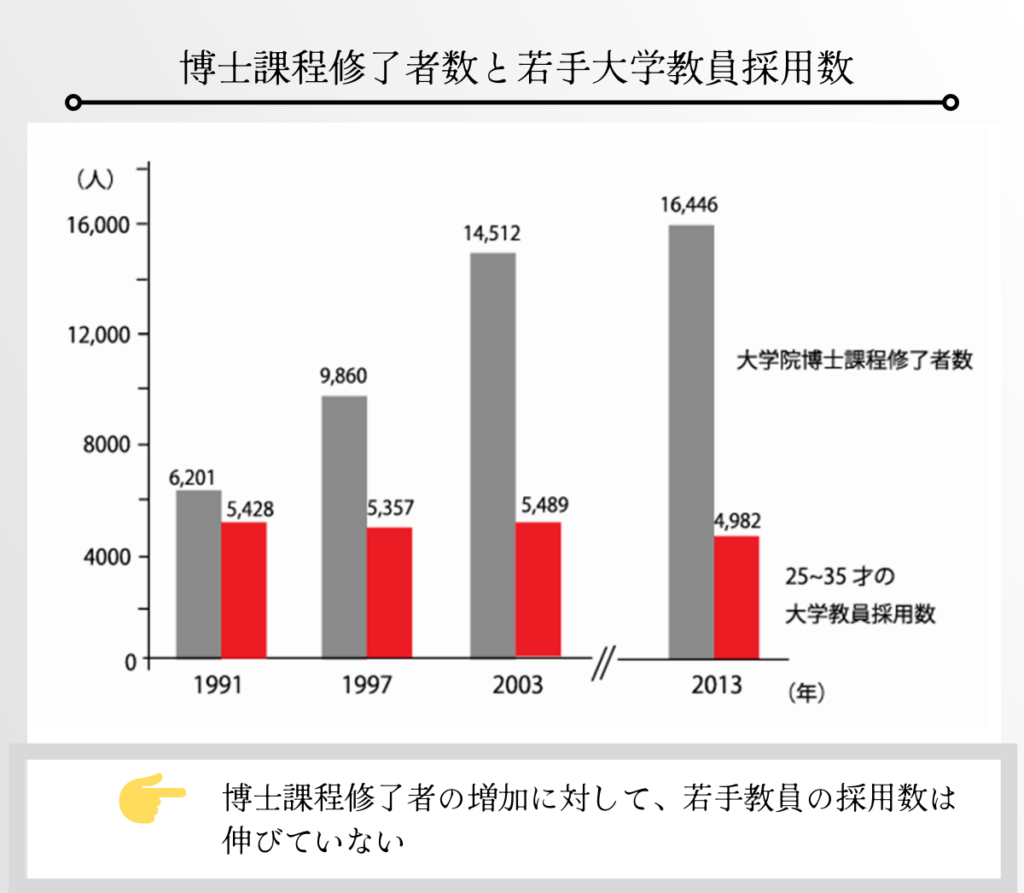
This is why the number of post-doctoral fellows far exceeded the original 10,000, reaching 17,000 at one point (see figure below).
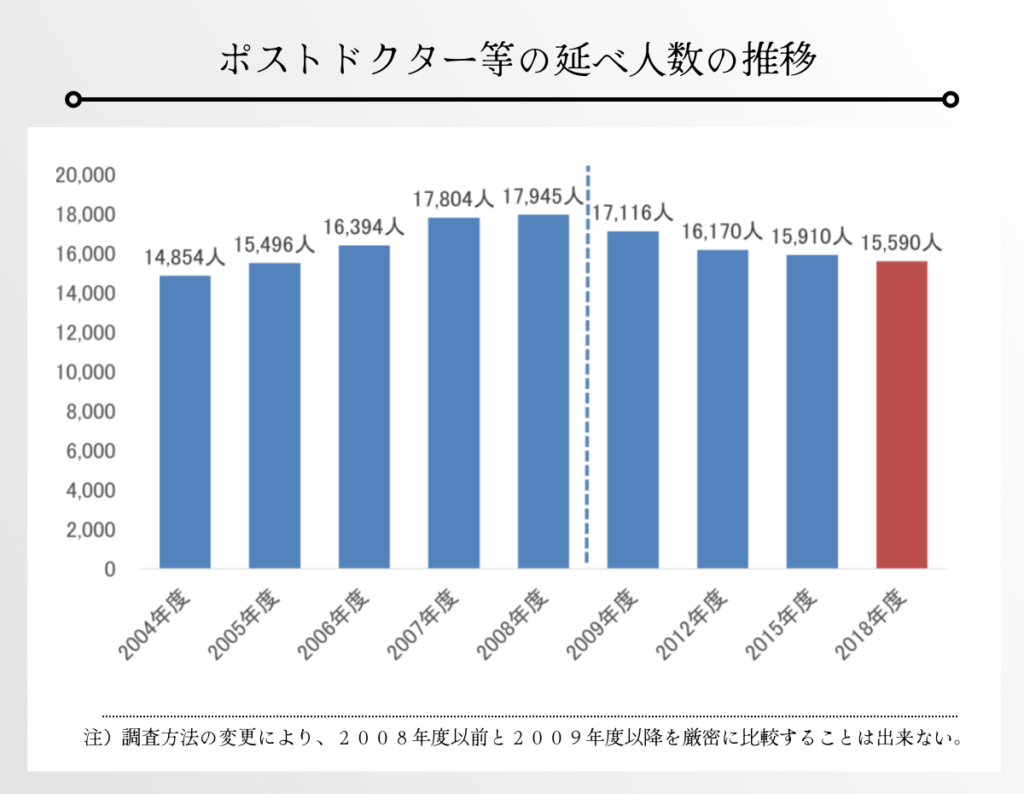
It may be said that this policy has resulted in a negative image of the career path of Ph.
However, the reality is that in the current laboratory situation in Japan, research activities are supported by the work of postdoctoral fellows.
Current Postdoctoral Issues
Current post-doctoral issues
- employment situation
- way of working
- annual income
Please refer to the following article for more details. (This article is STEP 3)
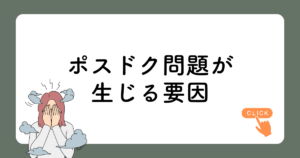
Books used for reference
This article is based on the following book written by Dr. Eisuke Enoki. This article is based on the following book written by Dr. Eisuke Enoki.
 Akanon
AkanonI learned a great deal about the history of the company and its future prospects, and I recommend it!
 Akanon
AkanonThank you for reading to the end.
Article updates are also posted on X and Instagram.
Please follow us and check it out!
- click here
- Click here for the installation.
- Click here for YouTube (in preparation)
- Click here for NOTE

request
Thank you for taking the time to read this article.
This is a personal site that the operator updates little by little in between his personal life.
If you found the content of this site helpful,
We would be happy to receive feedback on social networking sites.
The feedback we receive will encourage us to create future articles.

